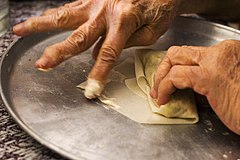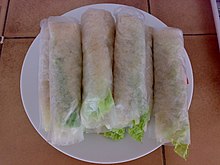Lumpia: Difference between revisions
No edit summary |
|||
| Line 36: | Line 36: | ||
====Lumpiang Sariwa==== |
====Lumpiang Sariwa==== |
||
[[Image:Fresh lumpia.jpg|thumb|''Lumpiang sariwa'' – Fresh ''lumpia'']] |
[[Image:Fresh lumpia.jpg|thumb|''Lumpiang sariwa'' – Fresh ''lumpia'']] |
||
''Lumpiang Sariwa'', or ''fresh spring rolls'' in English, consist of minced ''ubod'' ([[heart of palm]]), flaked [[chicken]], [[peanut|crushed peanuts]], and [[turnip]]s as an extender in a double wrapping of [[lettuce]] leaf and a yellowish egg [[crepe]]. The accompanying sauce is made from chicken or pork stock, a [[starch]] mixture, and [[garlic|fresh garlic]]. This variety is not fried and is usually around 2 inches in diameter and 6 inches in length; it is also the most popular among the Filipino variants. |
''Lumpiang Sariwa'', or ''fresh spring rolls'' in English, consist of minced ''ubod'' ([[heart of palm]]), flaked [[chicken]], [[peanut|crushed peanuts]], and [[turnip]]s as an extender in a double wrapping of [[lettuce]] leaf and a yellowish egg [[crepe]]. The accompanying sauce is made from chicken or pork stock, a [[starch]] mixture, and [[garlic|fresh garlic]]. This variety is not fried and is usually around 2 inches in diameter and 6 inches in length; it is also the most popular among the Filipino variants{{Fact}}. |
||
It is derived from the original Chinese [[popiah]]. |
It is derived from the original Chinese [[popiah]]. |
||
Revision as of 08:37, 17 June 2009
This article needs additional citations for verification. (January 2009) |
 Lumpia being prepared for frying | |
| Alternative names | loempia |
|---|---|
| Course | Main course or Snack |
| Place of origin | China |
| Serving temperature | hot or room temperature |
| Main ingredients | crepe, meat, vegetables |
| Variations | fried or fresh |
| 219[1] kcal | |
Lumpia are pastries of the Philippines and Indonesia of Chinese origin and are similar to spring rolls. The term lumpia derives from lunpia (Chinese: 潤餅; pinyin: rùnbǐng; POJ: jūn-piáⁿ, lūn-piáⁿ) in the Hokkien language. The recipe, both fried and fresh versions, was brought by the Chinese immigrants from the Fujian province of China to Southeast Asia and became popular where they settled in the Philippines and Indonesia. In the Netherlands, it is spelled loempia which is the old Indonesian spelling for lumpia and has also become the generic name for "spring roll" in Dutch. A variant is the Vietnamese lumpia, wrapped in a thinner piece of pastry, in a size close to a spring roll though the wrapping closes the ends off completely, which is typical for lumpia.
Varieties
Indonesian
Lumpia Basah
It literally means "wet spring roll" which means spring roll without frying. It is similar to the Vietnamese spring roll with bean sprouts, carrots, shrimp and/or chicken, and served with sweet tauco (another Hokkien word for salted soybeans) sauce.
Lumpia Semarang

Named after the capital city of Central Java in Indonesia, Semarang. It was created by Chinese immigrants in the city of Semarang. It is filled with bamboo shoots, dried shrimp (ebi in Indonesian) chicken and/or prawn. It is served with lumpia sauce that is made from dried shrimp (optional), coconut sugar, red chillies, bird's eye chilies, water, ground white pepper, tapioca starch and water and can be served in either fried or unfried condition.
Filipino
Lumpia Hubad
Lumpiang Hubad literally means naked spring roll. It is basically an unwrapped Lumpiang Sariwa (without the crepe).
Lumpiang Sariwa

Lumpiang Sariwa, or fresh spring rolls in English, consist of minced ubod (heart of palm), flaked chicken, crushed peanuts, and turnips as an extender in a double wrapping of lettuce leaf and a yellowish egg crepe. The accompanying sauce is made from chicken or pork stock, a starch mixture, and fresh garlic. This variety is not fried and is usually around 2 inches in diameter and 6 inches in length; it is also the most popular among the Filipino variants[citation needed]. It is derived from the original Chinese popiah.
Lumpiang Shanghai
This type of lumpia is filled with ground pork or beef, minced onion, carrots, and spices with the mixture held together by beaten egg. It may sometimes contain green peas. Both lumpiang shanghai and the sweet and sour sauce are served which attests to the Chinese influence. This variety is by standard an inch in diameter and approximately 4-6 inches in length. However, most restaurants and street vendors often serve lumpia shanghai in smaller diameters, typically one-half to three-quarter inches, and is served with a spicy sauce instead of a sweet and sour sauce.
Lumpiang Prito/Lumpiang Gulay

Lumpiang Prito literally means fried spring roll. It consists of a briskly fried pancake filled with bean sprouts and various other vegetables such as string beans and carrots. Small morsels of meat or seafood may also be added. Though it is the least expensive of the variants, the preparation – the cutting of vegetables and meats into appropriately small pieces and subsequent pre-cooking – may prove taxing and labor-intensive. This variant may come in sizes as little as that of lumpiang shanghai or as big as that of lumpiang sariwa. It is usually eaten with vinegar and chili peppers, or a soy sauce-and-calamondin juice mixture known as toyo-mansi.
Lumpiang Ubod
This is another variation of the Filipino spring rolls which is made from coconut julienne or heart of palm. Lumpiang Ubod is a specialty of Silay City, Negros Occidental.
Banana Lumpia or Turon
Banana lumpia or Turon is a Philippine dessert, made of thinly sliced bananas (preferably ripe plantains), a slice of jackfruit, dusted with brown sugar, rolled in a papery wrapper and fried. Brown sugar is further added while frying for additional sweetness.
Popularity
Lumpia has such enduring popularity that one can see at least one variant in almost any set of Filipino or Indonesian festivities. Its distinct taste and ease of preparation (the Shanghai variant at least) has caused it to be one of the staple food products on the menus of many Filipino restaurants in the United States, including Lumpia Pansit atbp., Jollibee and Chowking.
External links
See also
References
- ^ "Lumpia Recipe". Retrieved 2009-01-28.
